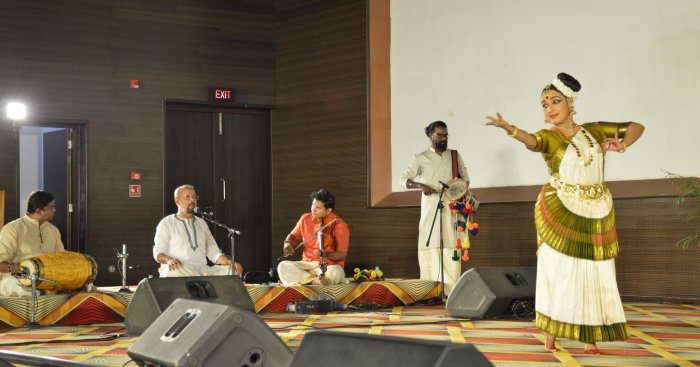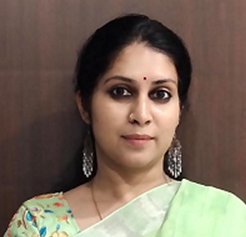
|
 |

|
 |
On Mohiniyattam's ascent - Mythili Maratt Anoop e-mail: mythili.moham@gmail.com March 29, 2024 Mohiniyattam, like other theatrical arts of Kerala, has been dramatic, but the real-life drama that unfolded in the past few days has catapulted Mohiniyattam to the segment of main/ hard news from being perhaps a byte in the arts and culture segment. Mohiniyattam became the hotbed of controversy with the instance of an alumnus from Kerala Kalamandalam making derogatory comments on the gender and skin colour of an established male artiste, teacher, and scholar, Dr R LV Ramakrishnan and the whole community of Mohiniyattam dancers standing up for him on the social media. Numerous opinions and support writing surfaced in solidarity with him. An issue such as this, in our context where there is growing sensitivity to issues relating to gender, caste, beauty norms (I wish, I could add religion too), is a sure shot way to stir up a hornet's nest, which is a good thing for the dance and the artists involved, as ultimately, all news is, after all, good news. In the past few days, I had several friends, family who had no stakes in Mohiniyattam, sharing video clips of the canonical interview, and opinion pieces with me on whatsapp, and that vouches for the ability that such issues have in generating public interest. Mohiniyattam has certainly outrun the 'Mohini', the practice of several male Mohiniyattam artistes and academic discourse has reflected this turn for more than a decade, and now the debate has found a loud finale in the public realm of social media.  Neena Prasad at GITAM, Hyderabad It is the vision articulated by practitioners through their performance and the accompanying discourse, particularly of those performers who have gained entry into the performance circuits of big festivals, and prominent organisations that can forge and re-create the popular conceptions of dance forms. GITAM University, Hyderabad, recently hosted the Nrithya Kalanidhi awardee, Mohiniyattam artiste Dr Neena Prasad for a SPIC Macay programme. Neena Prasad's progressive and thought-filled pieces are instances of a promising trajectory of the dance's future which an organisation such as the Madras Music Academy recognized through the award. All in all, her performance at GITAM, Hyderabad, balanced the intricacies of the craft with the force of moving narratives, to result in a dynamic and power-packed performance. As faculty in the same university in Mohiniyattam for over a year, I have experienced with frustration the bland response of a majority of students to Mohiniyattam in contrast to the more colourful and overt form of Kuchipudi, and was especially glad that a SPIC Macay performance by a Mohiniyattam artiste would engender some interest in the dance. Neena Prasad's performance began with the Cholkettu (an invocatory dance) in Hamsadhvani and Khanda Jathi Triputa taala demonstrated her strong grip over the form and the taala, with her characteristic poses that punctuated the movements. The next composition set in raaga Vasanta in the pattern of a kriti, Vasundara sundaram dhaatri, an ode to the planet, wove together narratives from mythology and the very topical ecological issues in a crisp and effective way. Her narration before each piece, made the compositions accessible to audiences, especially the impatient GenZ and her mirroring of typical device usage behaviour struck an amusing chord.  Neena Prasad The narrative of the major piece she performed was drawn from Pratibha Ray's novel, Yajnaseni, and was based on Draupadi's experience in the Sargarohana Parva of the Mahabharata. The lines of the varnam were written by a percussionist, Sri Ravi and the music was set in Lathangi raaga. The poignant feminist take on Draupadi's life, wherein she asks Krishna not for salvation, but an opportunity to be reborn in an ordinary family to experience the freedom of childhood, the love of a single man who would stand by her, the joys of motherhood and old-age, was powerful in terms of the abhinaya / acting. The format of the varnam enabled the dancer's quick transitions between the technical aspects of nritth and the emotional involvement required in abhinaya. Neena Prasad concluded with a thillana in Kapi raaga. Her performance demonstrated her versatility in the technical and narrative aspects of the dance, her unfailing energy and form, maintained until the very end of the performance, and the impeccable dynamics evolved over years with her musician and composer, Madhavan Namboodiri, whose voice mirrored the emotions depicted by the dancer. The accompanists, K P Ramesh Babu on mridangam, Kalamandalam Arun Das on edakka, and Kolanka Sai Kumar on violin were integral to crafting the impactful performance. Neena Prasad's unfailing commitment to the dance over three decades and her artistic vision is laudable, and inspiring for artistes like me, who explore the frontiers of the dance through creative choreographies and research-based writing that engages with the values the dance reinforces. Mohiniyattam has evolved along diverse strains that negotiated the regional and pan-Indian characteristics in complex ways. While some exponents have followed the shastra-based approach in codification of technique and expansion of repertoire, Guru Nirmala Panikker's Desi repertoire countered the former by drawing from indigenous practices and archival material and recreating abandoned dances such as Poli, Mukutty and Chandanam.  Mughlai vesham at State Museum, Hyderabad In an IFA (India Foundation for Arts) Arts Exploration, I set the groundwork to evolve a discarded piece, called the Mughlai vesham in Mohiniyattam, which questions premises of religion, and the norms of the classical. The set of compositions that went by the name Hindustani does not fit into the modern definition of Mohiniyattam as a classical form, but was very much a part of the earlier repertoire documented by Betty True Jones in her research conducted in Kerala in the late sixties. This was a time when variety in presentation was valued over adherence to the distinctive framework of the dance form. My own attempt in the IFA project has been to reimagine the Mughlai Vesham today. In popular imagination, the Mughlai is associated with cuisine and fashion and in an allusion to the same, I performed the Hindustani pieces in unconventional performance spaces, such as a restaurant and a public museum to reinforce the idea that dance is also amusement, and need not always be seen as an act of devotion or a spiritual offering to the gods. With multiple creative projects by enterprising artistes that reconfigure the popular definitions of the dance, and the proliferation of discourse surrounding its history, aesthetics and representational value, it is indeed a fervent time for Mohiniyattam.  Mythili Anoop is a Mohiniyattam artiste, holds a Phd in the Semiotics of Mohiniyattam from IIT Bombay, and is working as Associate Professor and Coordinator of the new Fine and Performing Arts Department at GITAM University, Hyderabad campus. She also runs her institute, Moham Attakalari in Hyderabad. Post your comments Pl provide your name and email id along with your comment. All appropriate comments posted with name & email id in the blog will also be featured in the site. |